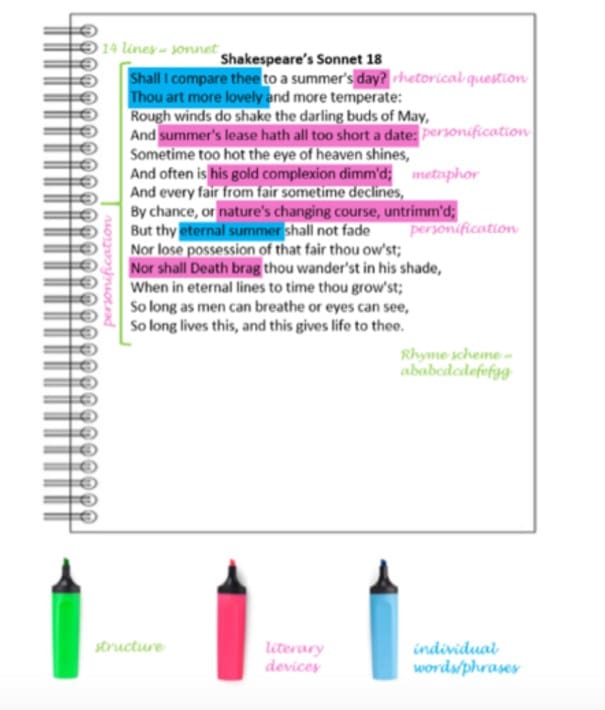After you have read and understood the essay questions, you are required to read and analyse the two texts provided for you in Section A of the exam. Knowing how to annotate texts effectively, will help you reduce the time it takes you to plan in the exam and it will also prevent you from having to read back over the whole text, saving you a lot of time.
There are a number of ways to annotate texts and it depends which one is more effective for you. Some of the most common techniques used to annotate texts are:
- Underlining certain words and structural and literary devices is a good technique when annotating texts; some students decide to colour coordinate the bits of information they pick out so they can easily refer to it when it comes to answering the question
- Circling certain words and structural and literary devices is a similar technique to underlining and works just as well.
- Writing in the margins of a text (an example will be provided) is an effective technique to use if you need to add more information when annotating. Sometimes, it can be difficult to remember why you have underlined or circled a certain word and so writing in the margins provides you with enough information to refer back to later. It also means that you can include what effects they have created so you do not forget when writing your essay.
- Highlighting (an example will be provided) can be a better technique for some students. This is because highlighting stands out a lot better than underlining or circling a word or device.
There are a few things to look out for when annotating a text. The main thing to always remember is that with every text you should always be able to recognise its purpose, audience, form and tone (PAFT), and from this you should be looking out for the following techniques which add to the effect the writer is trying to create: structural techniques, literary devices, characterisation and narrative voice, and themes and ideas. Not every text you come across will require you to look out for all of these, however, having a good knowledge of all of them and knowing what to look out for will benefit you in the exam, nonetheless.
When annotating structural techniques, you should look out for:
- Paragraph lengths
- Sentence structures
- Sentence lengths
- The overall shape of the text
- Repetition – any words that are repeated throughout the text
- Rhyme scheme (only if there is one)
When annotating literary devices, you should look out for:
- Any figures of speech: metaphors, personification, similes etc.
- Any language features: alliteration, sibilance, rhetorical questions etc.
When annotating characterisation and narrative voice, you should look out for:
- Is the text written in first, second or third person?
- Is the narrator a part of the text or a character in the story?
- Does the text tell us anything about the personality of the writer?

When annotating themes and ideas, you should look out for:
- Any words or phrases that relate to the main theme of the text (remember, a text can have more than one theme, especially longer ones)
Annotating a range of texts should be practised regularly if you want to complete the exam successfully. If you struggle finding texts to analyse, use the extracts that have been provided throughout this course and analyse and annotate them.



